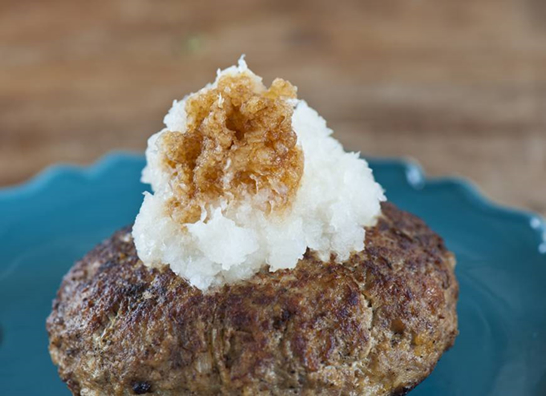 Posted on The Japan Times on Dec 18, 2015 by Makiko Itoh
Posted on The Japan Times on Dec 18, 2015 by Makiko Itoh
Grated radish on a meat pattie | MAKIKO ITOH
According to the Ministry of Health, Labor and Welfare, the most popular vegetable in Japan is the daikon radish, beating out onions and cabbage. Both the white roots and green tops are eaten throughout the year in many ways: raw, pickled, as sprouts, dried and simmered. Daikon are available year-round, but winter varieties are thought to have the sweetest flavor, perfectly suited to hot, simmered dishes.
Radishes most likely originated in the Mediterranean region, but they had already reached Japan by the 3rd or 4th century — although initially only the green tops were eaten. The tender young leaves of the radish plant have been included as one of the nanakusa, the seven herbs that are traditionally eaten in rice porridge in January to wish for health and longevity during the year.
While the greens are rich in vitamins and minerals, the most versatile part of the vegetable is the root, which became widely cultivated during the early Muromachi Period (1392-1573).
Daikon come in many shapes and sizes, ranging from the standard type, which are about 10-15 cm in diameter, to the huge Sakurajima variety, which looks like a gigantic turnip and can weigh as much as 30 kg. (Incidentally, small red radishes were called “20-day daikon” until recently, although these days the imported word radisshu is used more often.)
The most common use for daikon is so ubiquitous that it’s hardly thought of as cooking: daikon oroshi (raw grated). Daikon oroshi is used as a condiment in many meat and fish dishes, as well as a refreshing addition to tempura sauce (tentsuyu) and soba noodle sauce. This way of using grated raw daikon seems to have started in the Edo Period (1603-1868), when it was thought to aid digestion. It turns out that this belief was right. Daikon is an excellent source of the digestive enzymes diastase, amylase and esterase. These enzymes become much easier to absorb when the daikon is grated.
Grated daikon is good with a rich, oily fish — like mackerel — but it’s also great on steaks, hamburgers and other meat dishes. It’s similar to horseradish, but less pungent.
Though the digestive enzymes as well as the vitamin C in daikon are destroyed by heat, when cooked it can still aid digestion because of its fiber content. This is one reason why the vegetable is essential to oden, the stew made up mostly of fried fish-paste products. Of course, simmered daikon is delicious since it absorbs the flavors of the broth and becomes sweet and tender. It is also believed to warm the body, according to traditional Chinese medicine theories.
Dried daikon strips, known as kiriboshi daikon, which are rehydrated before cooking, and pickled daikon were also important staples, especially during the winter months. The most famous type of pickle is the takuan, which takes months to make and is thought to have been invented by the Zen Buddhist monk Takuan Soho.
In recent years there has been a renewed interest in daikon as a healthy food. One recent fad is to mix grated daikon with plain yogurt and honey, a concoction that keeps you regular.
Buri (amberjack) daikon is a classic simmered dish eaten during winter, which makes good use of the seasonal, oil-rich fish. The dish is usually made with the ara (the head and bones left over after the fish is filleted) but the recipe here is an easier version that uses precut filets.
Check out the great recipe of Daikon here:
http://www.japantimes.co.jp/life/2015/12/18/food/daikon-great-radish-japan/#.Vox0tr_OFOQ
